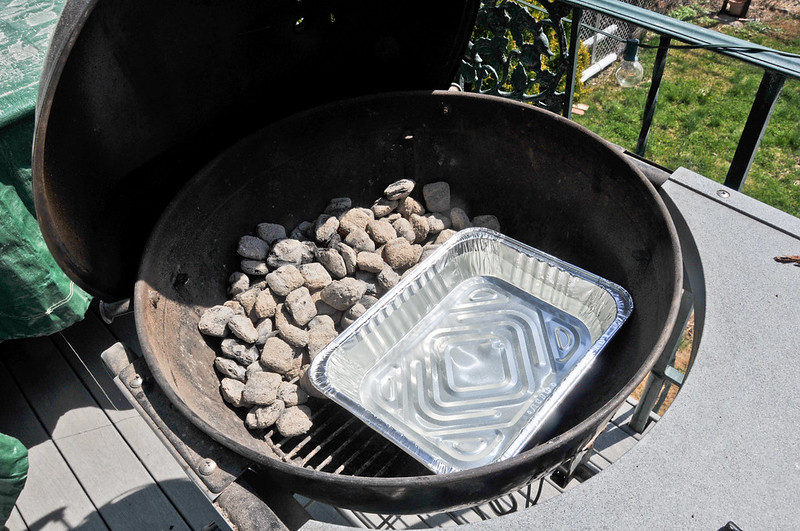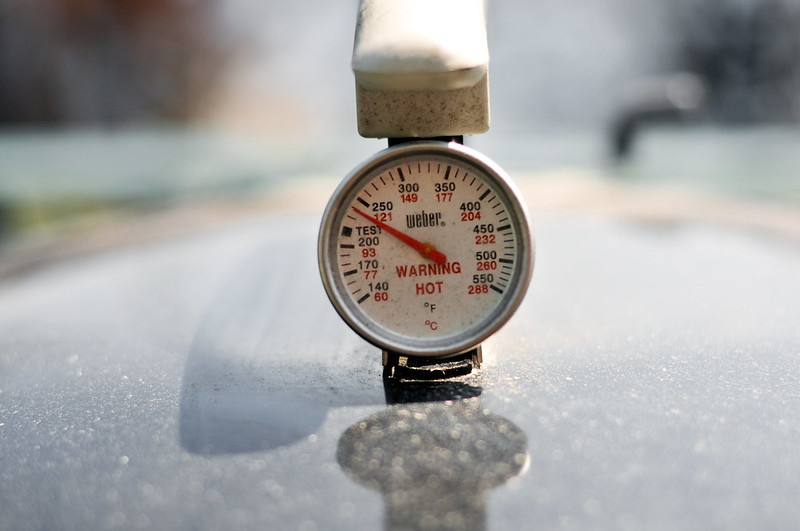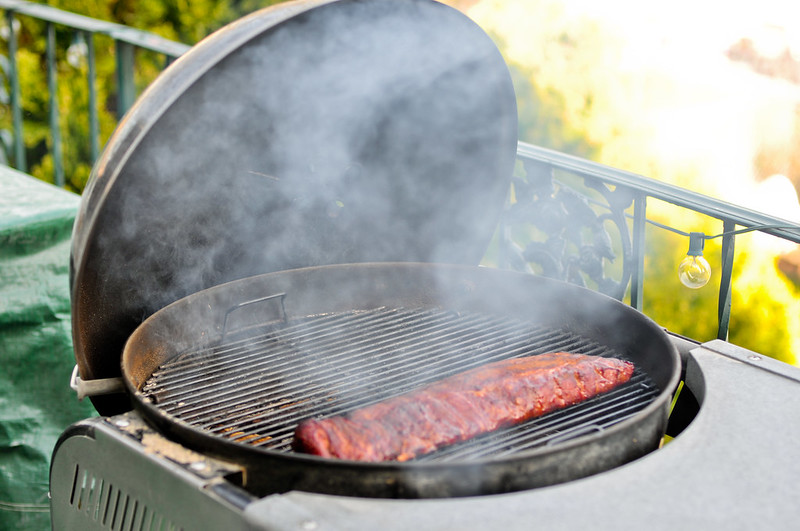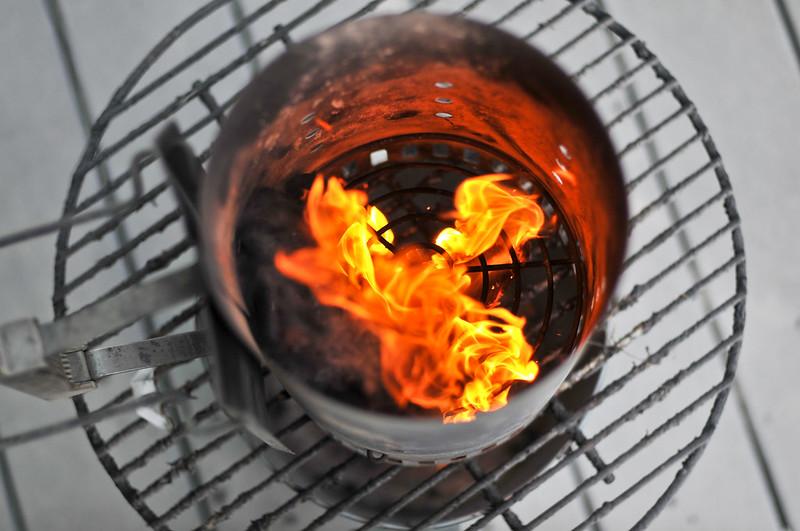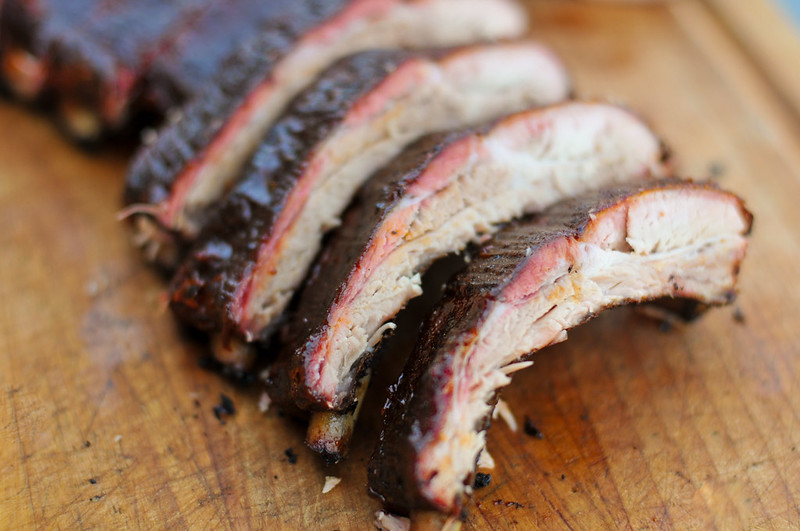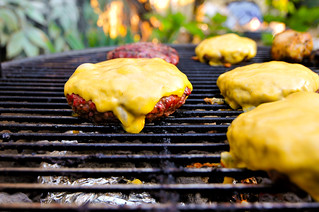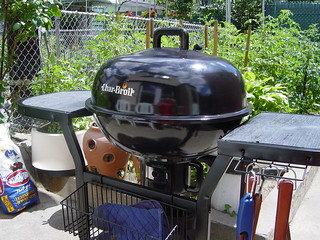Meat Tips: How to Smoke on a Charcoal Kettle Grill
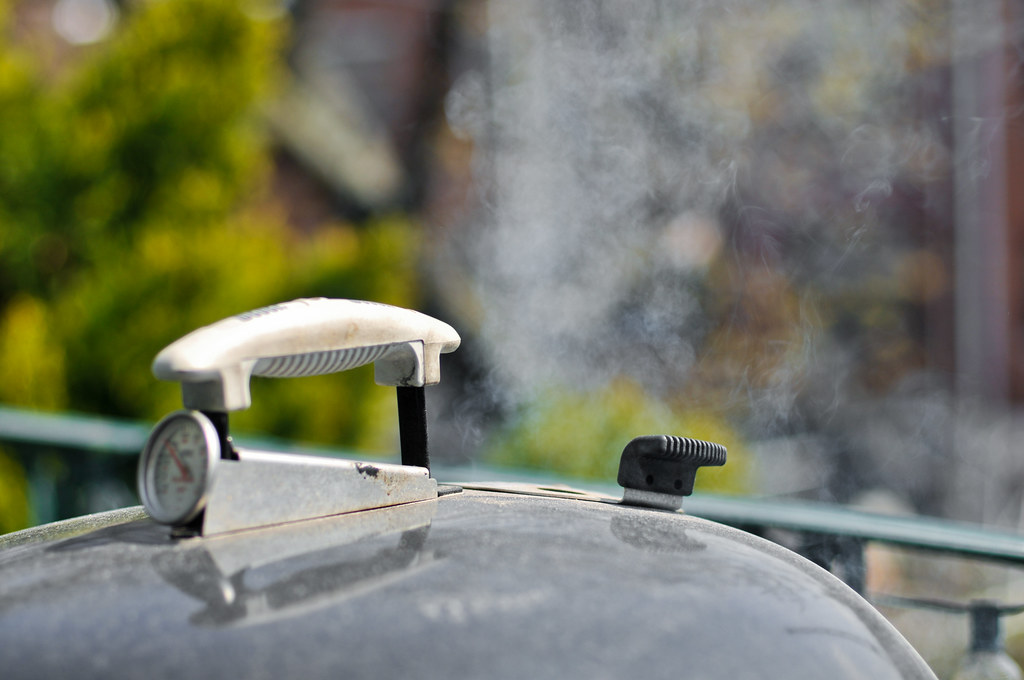
There's equal comfort in both smoking and grilling at home for me—whether it be a 16-hour slow smoked pork shoulder or quickly fired skirt steak, both are easily achievable. I often forget that the recipes I post for smoked ribs, brisket, and turkey may seem daunting or unachievable to the standard backyard chef with only one kettle grill. This isn't the case though, and nobody should be denied the satisfaction of taking a large, tough piece of meat and transforming it into something of sheer ecstasy by smoking it low-and-slow—and yes, this can be accomplished on the grill.
What is Smoking?
For those new to smoking and making barbecue, simply put, it's slow cooking a piece of meat at a very low temperature while burning hardwood in the form of chips, chunks, or logs. For pieces of meat like pork shoulders or brisket, this process breaks down the fat and connective tissues that would otherwise make the meat tough, leaving nothing but tender, juicy, smokey goodness behind. To accomplish this on a standard charcoal kettle, we need to figure out how best to set up to grill and then maintain the low cooking temperature required for this process to happen, which is not the simplest feat.
Setting up the Grill
A kettle grill is a heat machine, designed for that extreme temperature that makes seared steaks and burgers cooked over hot coals so great. Taking it in the opposite direction and trying to keep a steady, low temperature requires extra work and vigilance, but with practice, it can preform the task fairly well.
The first step is finding the proper arrangement between coals and food. Since we want the food to exposed to even, low heat, that calls for a two-zone indirect fire, where all the coals are set to one side of the charcoal grate, and food is place over the cool side of the grill.
To get this started, light a 3/4-full chimney of charcoal. When the coals are covered with gray ash, pour it out and pile into one side of the grill. Then, on the opposite side of the charcoal grate, place a disposable aluminum pan and fill it halfway with water.
The water pan here serves a few purposes. First, the pan will catch any drippings from the slowly rendering fat, keeping your grill clean. Second, the water helps regulate and stabilize the temperature in the grill. Third, as the water evaporates, it's adding moisture to the grill, helping keep the meat moist through the long cook.
Once the coals and water tray are in place, add a few chunks of hardwood until they ignite and start to smoke. Now it's time to get that grill heat way down.
Maintaining a Low Temperature
One reason a kettle can get so hot is the way air circulates through the open grill: More air equals a hotter fire. So to get a nice, low heat, airflow needs to be restricted as much as possible without extinguishing the fire.
To get the initial temperature drop once the grill is set up for smoking, set the cover in place and completely close the bottom air vent and close the top air vent so it's only about 1/3 of the way open. The initial temperature drop from high heat to medium or medium-low is pretty quick, followed by a slower decline into the 225-250 degrees range desirable for smoking.
Once the temperature hits around 250 degrees, it's time to add the meat on the grill grate, placed right above the water pan, away from the coals. When replacing the lid, position the top air vent in line with the meat and open it half way—this will keep the smoke flowing across the meat as it exits the grill.
Getting to a low temperature is the easy part; keeping it there is harder. Unlike my smoker, which is pretty set-it-and-forget-it, a low-heat fire in a grill requires nearly constant attention to ensure it keeps burning as desired.
For the sake of my own sanity, I shoot for 225 degrees, but accept a range up to 300 degrees, as the grill can easily and quickly fluctuate, and attempting a purely level heat is enough to drive one insane. Check the heat about every 15 minutes throughout the cook and use the bottom air vent to control the temperature—opening it more if the temperature drops and closing it if the temperature starts rising too much.
Inevitably, the fire will start to die out, which you can tell when the temperature starts dropping below 225 degrees and doesn't respond to changes to air flow, happening about every 60 to 90 minutes. At this point, add 12 to 15 lit coals to the fire, along with more wood chunks if the original set has burned away. While the lid is open for coal replenishment, this is also the best time to rotate the meat to ensure it's cooking evenly.
More Than One Way to Smoke that Meat
The process of lighting a full fire and getting the temperature to drop is my preferred method for shorter cooking items like ribs and chicken. For meats requiring longer cooks, like pork shoulder and brisket, I like to employ the Minion method.
This way of lighting the fire takes an opposite approach, starting with a bed of unlit coals on the charcoal grate, and adding to that 10-15 lit coals and the wood chunks. The grill is then covered and all vents left open. The temperature will rise from very low to the 225-250 degree range that's perfect for smoking. Once the grill hits that mark, the meat is added and cooking continues as described above.
While the minion method keeps a fire burning cooler and longer, the main disadvantage is that all the coals are not lit at the start, and processed products like Kingsford give off a chemical smell as they light. I have never actually tasted any off flavors left on the meat from this odor, so I have no qualms using the Minion method when I think it's most appropriate.
Telling When Food is Done
So you're now barbecuing on kettle, low and slow, but how do you tell when the food is done? Well, this is an extremely complicated question since each piece of meat has its own path to doneness. To get you started at least, here are ways to tell with the most popular barbecue items:
- Pork ribs: Lift ribs from the one end; the rack should bend slightly as you lift it, but not fall apart. This takes around 4-5 hours for baby backs, 5-6 hours for St. Louis cut, and 6-7 hours for full spare ribs
- Pork butt: Cook to 185 degrees if you intend to chop it, or 195 degrees if you want to pull it, 12-16 hours
- Beef Brisket: Brisket is done when the meat reaches between 190-195 degrees, 14-18 hours
For all of these meats, it's good to give them a rest before slicing and serving, about 10-15 minutes for ribs, and 30 minutes or more for pork butt and beef brisket.
Yes, this is a long time to keep a watchful eye on a fire, but your patience and persistence will be well rewarded at first taste of a beautifully slow smoked piece of meat, which is made even better after all those beers thrown back during the long wait, which to me at least, is the perfect day.
You Might Also Like
Comments
-
Chris Great write up, Josh, and just in time for the folks that are just breaking out their grills for "the season" and who may have not tried slow smoking yet.
-
Philip I got a Smokenator for my birthday - really impressed with the results.
http://www.smokenator.com/ -
CTMike Another happy Smokenator user. So glad to have my Weber kettle!
-
Nate M Smokenator is an amazing tool.
-
Taste Catering NC Great article! I felt like I really learned a lot! I have a Charbroil Large Barrel Grill ...I'm going to save your article and try this in a few days!
-
Charcoal Smoker I love this post: "Meat Tips: How to Smoke on a Charcoal Kettle Grill". Thanks for sharing !
